| ■ J-PARC News - February 2016 (Issue #130) |
| ● Toward Development of Next-Generation All-Solid Lithium Ion Batteries (January 20, featured on J-PARC home page) - Elucidating the Movement of Lithium Ions in Battery Materials - |
|---|
| In recent years, lithium ion (Li-ion) batteries have come into wide use in the society around us, and there is a need for even higher performance and stability. When installed in automobiles and aircraft, it is essential to take into account the risk of accidents due to battery trouble, and improve safety to address those risks. Therefore, as next-generation Li-ion batteries, there is a need to develop technology for making the entire battery solid by using superionic conductors as the electrolyte material. Recently, a research group led by Associate Professor Kazuhiro Mori of the Kyoto University Research Reactor Institute successfully elucidated the movement on Li-ions in batteries employing superionic conductors. This was achieved by using the neutron instruments NOVA and DNA at the Materials and Life Science Experimental Facility (MLF). On November 20 of last year, these results were featured in the U.S. physics journal Physical Review Applied, and chosen as an Editors' Suggestion. |
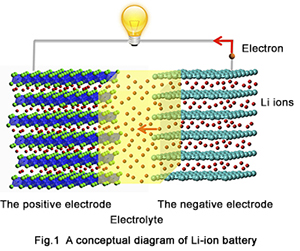
 * Click here to enlarge. * Click here to enlarge. |
|
| ● Speech Commemorating Receipt of the 2016 Breakthrough Prize by Koichiro Nishikawa, Professor Emeritus of KEK (January 29, IQBRC) |
|---|
| On November 9 of last year, Professor Emeritus Nishikawa of the High Energy Accelerator Research Organization (KEK) (former Deputy Director of J-PARC) and members of the K2K/T2K Collaboration (an international collaborative experiment group) jointly received the Breakthrough Prize in Fundamental Physics for their achievements in discovering and studying neutrino oscillation. Professor Emeritus Nishikawa was the originator of the K2K (KEK to Kamioka) experiment-the world's first long baseline neutrino oscillation experiment employing an accelerator-and its successor, the T2K (Tokai to Kamioka) experiment. In both of these experiments, he has worked as a representative, and helped to move the projects forward. At the collaboration meeting of the T2K experiment held at the Ibaraki Quantum Beam Research Center (IQBRC) on January 25-30, Professor Emeritus Nishikawa delivered a commemorative speech regarding the progress of these experiments in Japan. The speech was attended by about 200 researchers from overseas, and by Dr. Takaaki Kajita, Director of the Institute for Cosmic Ray Research, University of Tokyo-2015 Nobel laureate in physics and a collaborating researcher in the T2K experiment. At this meeting, there were also reports on maintenance of the neutrino production target from the end of last year, and lively discussions on analysis of antineutrino oscillation going forward. |
| |

 * Click here to enlarge. * Click here to enlarge. |
| |
| ▲to Page Top |
| |
|
| ● Symposium on the Master Plan for "Large Facility and Large-Scale Research Projects" in the Field of Particle and Atomic Physics (February 12, Auditorium, Science Council of Japan, Tokyo) |
|---|
| Japan's Master Plan for Large Facility and Large-Scale Research Projects is being formulated primarily by the Science Council of Japan, acting as representative of the scientist community. However, due to rapid progress in science and technology, and the situation relating to international competition, the plan is being updated while obtaining the understanding of society and the Japanese people. This recent symposium was held to discuss projects in the field of particle and atomic physics, as part of the process of moving toward the public appeal stage of the Master Plan. J-PARC has accelerators and experimental facilities which lead the world for research in this field. Naohito Saito, Director of the J-PARC Center, spoke on the topic of "Elucidating the Origins of Matter by Increasing the Sophistication of J-PARC Experimental Facilities," and views were exchanged on a variety of topics such as the research outlook expected by the scientist community, and new expansion of facilities necessary for realizing the aspirations of scientists. |
| |
| ▲to Page Top |
| |
|
| ■ J-PARC Muon Advisory Committee (MAC) (February 14-15, KEK Tokai Bldg. No. 1) |
|---|
| The Muon Advisory Committee (MAC2015) was held concerning the Muon Science Establishment (MUSE) of the J-PARC/MLF. The committee listened to an explanation of the current situation at J-PARC from Naohito Saito, Director of the J-PARC Center, as well as his requests for the MAC. Then there were reports on the current status of MLF, MUSE and joint use. After that, the various people in charge gave results on the current situation of the rotating graphite target, maintenance of the D-line, U-line and S-line, and safety efforts by the Muon Safety Task Force to protect against radiation in the M1 and M2 tunnel. During these reports, there was a lively exchange of questions, answers and views with the committee members regarding the details, and on the second day, Chairperson Pratt provided an overview of the inquiry. The plan is to report these results to the J-PARC International Advisory Committee which will be held from February 29 to March 1. |
| |
| ▲to Page Top |
| |
|
| ● Mercury Target Vessel International Review Committee (February 22, J-PARC Research Building) |
|---|
| At the MLF, technology development has been carried out to improve the level of vessel performance, and thereby achieve goals such as strengthening beam power and addressing the pressure waves which occur in the mercury. This development has been reflected in the design. However, last year there was a problem with the mercury target vessel, and the design is being improved in order to enhance its robustness. With an eye on the goal of 1 MW operation, eight experts were invited (four from Japan, four from overseas) and a review committee meeting was held in order to obtain an assessment of the appropriateness of the vessel design. Detailed reports were provided by the persons in charge regarding topics such as the approach to improving design of the vessel and improvement of the inspection system during fabrication. There was an extremely lively exchange of questions, answers and views on these topics. |
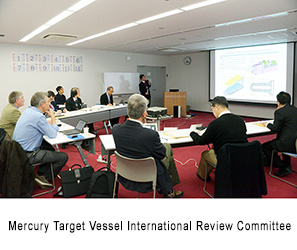
 * Click here to enlarge. * Click here to enlarge. |
| The results of the deliberations of this committee will be reported by the Chairperson B. Reimer at the Neutron Advisory Committee (NAC2016) to be held on the 23rd and 24th. |
| |

 * Click here to enlarge. * Click here to enlarge. |
| |
| ▲to Page Top |
| |
|
| ■ Second Meeting of FY2015 on Nuclear Power for Local Residents (February 9, J-PARC Research Building) |
|---|
| On February 9, a meeting on nuclear power was held with the aim of allowing residents and governmental officials to tour the J-PARC site and exchange views, and the participants included residents of Tokai Village, persons involved with local government, and persons involved with nuclear power. At the beginning, Naohito Saito, Director of the J-PARC Center, provided an overview of J-PARC and explained the accident at the Hadron Experimental Facility in May 2013. This was followed by a question-and-answer session. Next, the participants took a tour of the Hadron Experimental Facility, Materials and Life Science Experimental Facility, and Neutrino Experimental Facility. After that they returned to the conference room, and there was a general question-and-answer session and exchange of views. There were questions on topics such as the T2K neutrino experiment J-PARC is involved in, and how to maintain safety awareness with respect to accidents. |
| |
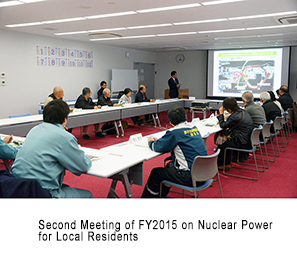
 * Click here to enlarge. * Click here to enlarge. |
| |
| ▲to Page Top |
| |
|
| ● SAT Technology Showcase 2016 Exhibited by J-PARC (February 4, Tsukuba) |
|---|
| Just like last year, the J-PARC Center presented a booth featuring our projects at the SAT Technology Showcase 2016 held by the Science Academy of Tsukuba (SAT). The aim of this event is to announce research results and product technologies, and promote interaction between researchers and engineers. As every year, there were over 100 poster presentations from a variety of fields. Many visitors stopped by the J-PARC booth, and there were many questions about accelerators and the neutrino experiment?by high school students who learned for the first time that there is a large facility in Ibaraki Prefecture, researchers surprised at the grand scale of the neutrino oscillation experiment, and other interested people. |
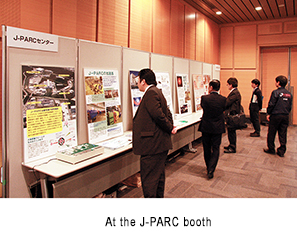
 * Click here to enlarge. * Click here to enlarge. |
| |
| ▲to Page Top |
| |
|
| ● International Symposium on Present Status and Future Perspective for Reducing Radioactive Wastes (February 17, Seiryo-Kaikan, Tokyo) - Challenge for the Relief in the Next-generation - |
|---|
| In order to deepen understanding of the needs for international cooperation, as well as the present status and future utilization of large research facilities, the Japan Atomic Energy Agency (JAEA) held an international symposium on the present status and future perspective for reducing radioactive wastes, with experts invited from France, China, the U.S., and India. William D. Magwood, IV, Director-General of the Nuclear Energy Agency of the Organization for Economic Cooperation and Development (OECD/NEA) delivered the keynote address, and this was followed by reports from participating countries. As one effort in Japan, the leader of the Nuclear Transmutation System Development Group of JAEA introduced a plan to build a J-PARC Transmutation Experimental Facility and thereby to promote R&D on nuclear transmutation technology. There was also a report on an R&D plan using an accelerator from China. In the final panel discussion, there was a lively exchange of views between the speakers and Reiko Fujita, Program Manager of the Impulsing Paradigm Change through Disruptive Technologies Program (ImPACT) of the Japan Science and Technology Agency. There was a shared understanding that international cooperation is essential for R&D for reducing radioactive wastes, that large research facilities can play a central role in that effort, and that it is crucial to win the understanding of the public for proceeding with this R&D. |
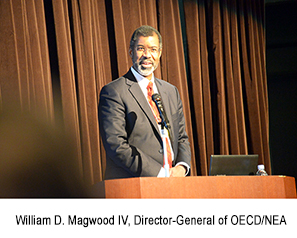
 * Click here to enlarge. * Click here to enlarge. |
| |

 * Click here to enlarge. * Click here to enlarge. |
| |
| ▲to Page Top |
| |
|
| ● Eric D. Zimmerman Winner of Best Photo in J-PARC FY2015 Photo Contest (January 29, KEK Tokai Dormitory) |
|---|
| The FY2015 photo contest was held by the J-PARC Center. Numerous photos were submitted by J-PARC staff, users and others, and were judged by staff involved in public relations from the standpoint of aesthetic beauty, internationality, public relations value, dynamism and other characteristics. A photo by Dr. Eric D. Zimmerman, who is engaged in the T2K Experiment, was selected as the Best Photo. In addition, 5 other photos were chose as outstanding works, and four photos for honorable mention. An award ceremony for the winners was held on the 29th at the KEK Tokai Dormitory, and the winners were presented with commemorative gifts. All of the winning photos are currently being showcased in a special exhibition at the J-PARC Research Building. To see all of the winning photos from the J-PARC FY2015 Photo Contest, please go to : http://www.j-parc.jp/PhotoCon/index_e.htmlfont |
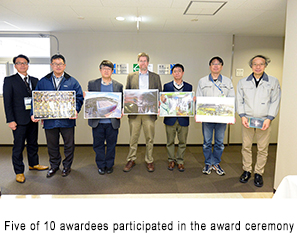
 * Click here to enlarge. * Click here to enlarge. |
| |
| ▲to Page Top |
| |
|
| ● Held Origami Class (January 29, KEK Tokai Dormitory) |
|---|
| The J-PARC Center held an origami class to coincide with the T2K Collaboration Meeting. The class was attended by 15 foreign researchers. The participants enjoyed a fun lunch break, looking over a text showing how to fold various origami creations, watching the Japanese staff actually fold them, and then folding their own : tops that spin, boxes for holding small items, card cases, and others. |
| |
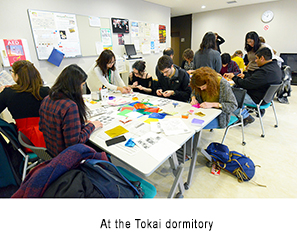
 * Click here to enlarge. * Click here to enlarge. |
| |
| ▲to Page Top |
| |
|
©2015 J-PARC Center. All rights reserved.
|
|